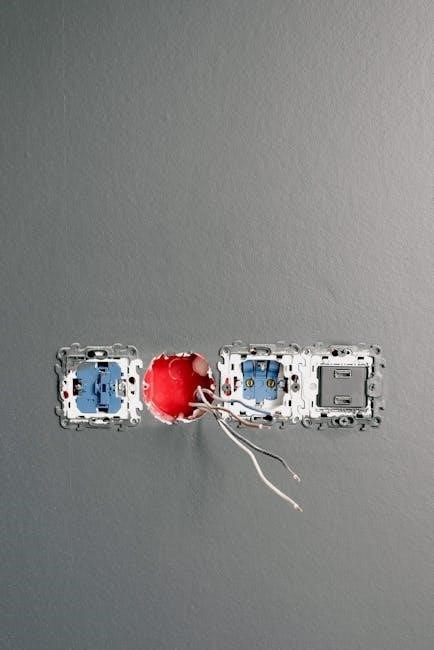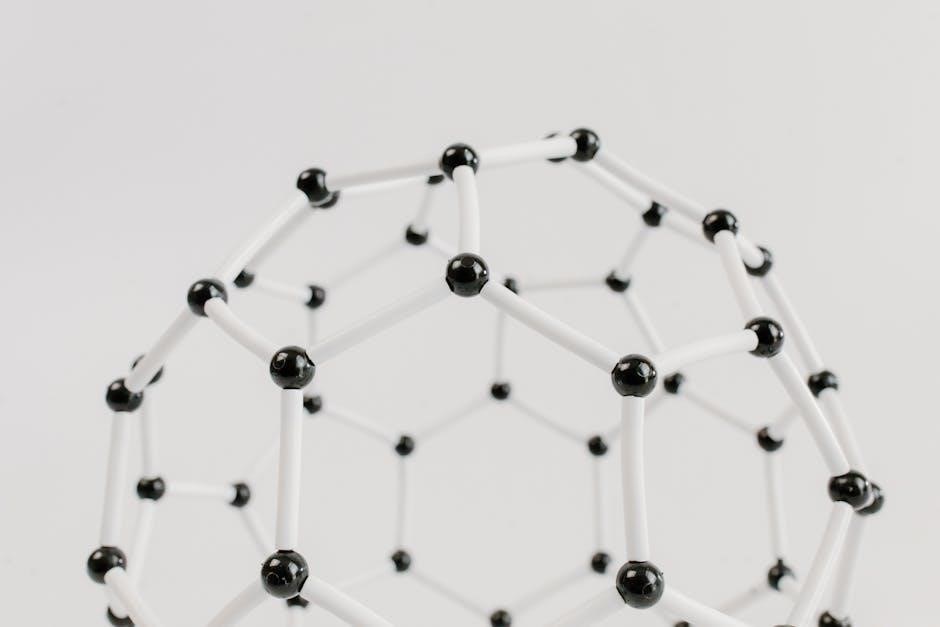This worksheet provides an interactive and comprehensive guide to understanding the skeletal system, offering various question types and activities to test knowledge and enhance learning.
Definition and Importance of the Skeletal System
The skeletal system is the framework of bones and cartilage that supports the body, protects vital organs, and facilitates movement. It also produces blood cells and stores essential minerals like calcium and phosphorus. Understanding its structure and functions is crucial for comprehending human anatomy and maintaining overall health and well-being.
Objective of the Worksheet
The objective of this worksheet is to assess knowledge of the skeletal system, promoting understanding of its structure, functions, and importance. It includes labeling diagrams, true/false questions, and short/long answer prompts to engage students and reinforce learning. The worksheet aims to provide a comprehensive review of skeletal anatomy, ensuring a solid foundation for further study in biology or healthcare.
Key Features of the Worksheet
The worksheet includes interactive labeling diagrams, multiple-choice questions, true/false statements, and short/long answer prompts. It covers axial and appendicular skeleton details, bone functions, and joint types. Answer keys and structured activities enhance learning, making it a robust tool for students to master skeletal system concepts effectively and engage with the material actively.

The Axial Skeleton
The axial skeleton includes the skull, vertebral column, sternum, and ribs, forming the body’s central framework and protecting vital organs like the brain and heart.
Definition and Bones of the Axial Skeleton
The axial skeleton is the central framework of the body, comprising 80 bones that form the skull, vertebral column, sternum, and ribs. It includes the cranium, mandible, maxilla, 33 vertebrae, and 12 pairs of ribs. These bones provide structural support and protect vital organs like the brain and heart, while also serving as attachment points for muscles and other skeletal components.
Functions of the Axial Skeleton
The axial skeleton provides structural support, protecting vital organs like the brain and heart. It serves as a central anchor for muscles and limbs, enabling movement and maintaining posture. The skull safeguards the brain, while the vertebral column supports the body and facilitates nerve communication. Ribs protect internal organs and assist in breathing, making the axial skeleton essential for both protection and bodily functions.
Labeling the Axial Skeleton Diagram
Labeling the axial skeleton diagram involves identifying and naming key bones such as the cranium, vertebrae, sternum, and ribs. This activity enhances spatial recognition and understanding of skeletal anatomy, helping students connect theoretical knowledge with practical visualization of the body’s structural framework. Accurate labeling ensures a clear grasp of the axial skeleton’s components and their relationships.

The Appendicular Skeleton
The appendicular skeleton includes 126 bones of the upper and lower limbs and girdles, facilitating movement and interaction with the environment.
Definition and Bones of the Appendicular Skeleton
The appendicular skeleton comprises 126 bones, including the upper and lower limbs and their girdles, facilitating movement and interaction with the environment. It includes bones like the clavicle, scapula, humerus, radius, ulna, carpals, metacarpals, phalanges, pelvis, sacrum, coccyx, femur, patella, tibia, fibula, tarsals, metatarsals, and phalanges, enabling locomotion and manipulation of objects.
Functions of the Appendicular Skeleton
- Facilitates locomotion and movement by providing attachment points for muscles.
- Supports the body’s weight and aids in balance.
- Enables manipulation of objects through upper limb bones.
- Protects certain internal organs, such as the reproductive system.
Labeling the Appendicular Skeleton Diagram
Students identify and label bones of the upper and lower limbs, including the clavicle, scapula, humerus, radius, ulna, metacarpals, femur, patella, tibia, and fibula; The worksheet also requires naming the shoulder and pelvic girdles, ensuring accurate recognition of appendicular skeleton structures to enhance anatomical understanding and classification skills effectively.

Functions of the Skeletal System
The skeletal system provides support, protects organs, facilitates movement, produces blood cells, and stores minerals like calcium, essential for overall bodily functions and maintaining health.
Support and Structure
The skeletal system acts as a framework, providing structural support and maintaining posture. Bones serve as attachment points for muscles, enabling movement and stability. This framework allows the body to stand upright and perform daily activities efficiently, ensuring proper alignment and balance of the body’s components. It is essential for overall physical stability and functionality.
Protection of Internal Organs
The skeletal system safeguards vital organs by surrounding them with protective bones. The skull encases the brain, while the ribcage shields the heart and lungs. Vertebrae protect the spinal cord, ensuring the body’s delicate systems remain safe from injury or damage. This protective function is crucial for maintaining overall health and preventing harm to essential organs.
Facilitating Movement
The skeletal system plays a vital role in enabling movement by providing a framework for muscles to attach and contract. Bones act as levers, while joints serve as pivot points, allowing for a wide range of motion. This integration of bones, joints, and muscles creates a functional system that supports voluntary movement and maintains posture.
Blood Cell Production
Bones contain bone marrow, the site of blood cell production; Red blood cells, which carry oxygen, white blood cells, which fight infections, and platelets, which aid in clotting, are produced here. This essential function highlights the skeletal system’s role in supporting life-sustaining processes and maintaining overall health through hematopoiesis.
Mineral Storage
Bones act as reservoirs for essential minerals like calcium and phosphorus, storing them for the body’s needs. This storage supports nerve and muscle function, blood clotting, and overall metabolic health. The skeletal system ensures these minerals are released as required, maintaining homeostasis and enabling vital bodily functions to operate effectively and efficiently.

Components of the Skeletal System
The skeletal system comprises bones, joints, muscles, ligaments, and tendons, working together to provide structural support, facilitate movement, and protect internal organs effectively.
Bones and Their Classification
Bones are classified into five types: long, short, flat, irregular, and sesamoid. Long bones, like the femur, support body weight. Short bones, such as carpals, provide stability. Flat bones, including the skull, protect organs. Irregular bones, like vertebrae, have unique shapes. Sesamoid bones, such as the patella, aid muscle function, enhancing movement and overall skeletal system efficiency.
Joints and Their Types
Joints are points where bones connect, allowing movement. They are classified into three main types: synovial, fibrous, and cartilaginous. Synovial joints, like the knee, permit extensive movement. Fibrous joints, such as those in the skull, are immovable. Cartilaginous joints, like the spine, offer limited movement. Each type plays a crucial role in facilitating various degrees of motion in the skeletal system.
Muscles and Their Role
Muscles play a key role in the skeletal system by enabling movement and providing stability. They are attached to bones via tendons, allowing for voluntary and involuntary movements. Voluntary muscles, such as those in the arms and legs, facilitate intentional actions, while involuntary muscles, like the heart, function automatically. Together, they support skeletal functions and enable various physical activities.
Ligaments and Tendons
Ligaments connect bones to bones, providing stability and support to joints, while tendons attach muscles to bones, enabling movement. Both structures are crucial for joint health and mobility. Ligaments prevent excessive joint movement, and tendons transmit muscle forces to bones, facilitating actions like walking or lifting. Together, they ensure proper skeletal function and prevent injuries.

Types of Bones in the Skeletal System
Bones vary in shape and function, classified as long, short, flat, irregular, and sesamoid. Long bones, like femurs, support body weight, while flat bones, such as the skull, protect organs.
Long Bones
Long bones, such as the femur (thigh bone) and humerus (upper arm bone), are elongated and cylindrical, with a shaft (diaphysis) and ends (epiphyses). They support body weight and facilitate movement. Their structure includes compact bone in the shaft and spongy bone in the ends, with a medullary cavity containing bone marrow, essential for blood cell production.
Short Bones
Short bones are cube-shaped and provide stability and limited movement. Found in the wrists (carpals) and ankles (tarsals), they absorb shock and distribute weight. Their structure includes a thin layer of compact bone enclosing spongy bone, making them strong and flexible. This design allows for stability while enabling some degree of movement in the joints they form.
Flat Bones
Flat bones are thin, plate-like structures that protect internal organs and provide broad surfaces for muscle attachment. Examples include the skull, sternum, ribs, and scapula. Their flat shape allows them to cover and shield organs like the brain and heart, while their broad surfaces enable muscles to attach securely, facilitating movement and supporting the body’s structure effectively.
Irregular Bones
Irregular bones have unique, complex shapes that do not fit into other categories. Examples include vertebrae, pelvis, and facial bones. These bones support, protect, and facilitate movement in specific areas, such as the spine and skull, while their irregular shapes allow for specialized functions, like accommodating joints or protecting vital organs, making them essential for overall skeletal stability and functionality.
Sesamoid Bones
Sesamoid bones are small, embedded bones within tendons, enhancing muscle function and reducing friction. The patella (kneecap) is the largest example, protecting the knee joint and aiding movement. These bones provide mechanical advantage, distribute pressure, and prevent tendon wear, playing a crucial role in locomotion and joint stability, while their small size allows for precise movement in areas like the hands and feet.

Understanding Joints and Their Functions
Joints connect bones, enabling movement, stability, and force distribution. They are classified into types like synovial, cartilaginous, and fibrous, each serving unique roles in mobility and structural support.
Types of Joints
Joints are classified into three main types: synovial, cartilaginous, and fibrous. Synovial joints, like knees and elbows, allow extensive movement. Cartilaginous joints, such as intervertebral discs, provide limited motion. Fibrous joints, like skull sutures, are immovable. Each type serves distinct functional roles in the skeletal system, supporting movement, stability, and structural integrity.
Structure of a Joint
A joint consists of bones held together by ligaments, a joint cavity, and a synovial membrane. The synovial membrane secretes synovial fluid to reduce friction. Articular cartilage covers the ends of bones, ensuring smooth movement. This structure allows for flexibility, stability, and efficient mobility, with variations adapting to different functional demands across the body.
Importance of Joint Health
Joint health is crucial for maintaining mobility, stability, and overall well-being. Healthy joints enable smooth movement and distribute forces effectively, preventing injuries and degenerative conditions like arthritis. Proper joint care through exercise and nutrition is essential for preventing pain and ensuring long-term skeletal functionality, supporting an active and healthy lifestyle.

The Role of Muscles in the Skeletal System
Muscles work with bones to enable movement, maintain posture, and stabilize joints. They contract and relax to facilitate actions like walking, lifting, and balancing, essential for daily activities.
Types of Muscles
Muscles are categorized into voluntary and involuntary types. Voluntary muscles, like those in the arms and legs, are controlled consciously. Involuntary muscles function without deliberate control, such as those in the digestive tract. Additionally, muscles are classified as skeletal, smooth, or cardiac, each serving distinct roles in movement, internal processes, and blood circulation, respectively.
Muscle Attachment to Bones
Muscles attach to bones via tendons, enabling movement. The origin is the fixed bone, while the insertion is the bone that moves. This attachment allows muscles to contract, pulling the bones to facilitate motion. Proper attachment is crucial for joint stability and effective movement, ensuring the skeletal system functions seamlessly with the muscular system.
Muscle Function in Movement
Muscles function by contracting, pulling bones to create movement. Voluntary muscles enable controlled actions, while involuntary muscles handle automatic movements. This interaction allows for walking, running, and precise gestures, demonstrating the skeletal and muscular systems’ coordinated effort to facilitate a wide range of motion and maintain posture.

Worksheet Questions and Answers
This section includes true/false, multiple-choice, short-answer, and long-answer questions to assess understanding of skeletal anatomy, bone health, and functions, with interactive activities like labeling diagrams.
True or False Questions
Test your knowledge with true or false statements about the skeletal system. For example, “The axial skeleton includes the bones of the skull and spine.” Such questions help reinforce key concepts and ensure understanding of skeletal anatomy. They cover various topics, from bone classification to joint functions, making them an effective learning tool for students. Critical thinking is encouraged through accurate and concise responses.
Multiple Choice Questions
Engage with multiple choice questions that cover key skeletal system topics. Examples include: “How many bones are in the adult human body?” with options like 206 or 210. These questions assess understanding of bone classification, joint types, and axial versus appendicular skeleton differences. They provide clear answer choices, making it easier for students to test their knowledge and identify areas for further study. This format is ideal for self-assessment and exam preparation.
Short Answer Questions
Short answer questions require concise responses, testing specific knowledge points. Examples include naming the two girdles in the skeletal system or describing bone functions. Students must provide clear, accurate answers, fostering critical thinking and comprehension. These questions are designed to reinforce learning and ensure mastery of key concepts in skeletal anatomy and physiology. They are ideal for detailed understanding and retention.
Long Answer Questions
Long answer questions allow students to elaborate on complex topics, such as the functions of the skeletal system or the structure of joints. These questions require detailed explanations, promoting deeper understanding and application of knowledge. They assess the ability to organize thoughts and provide comprehensive responses, ensuring a thorough grasp of the subject matter and its practical implications.

Interactive Activities in the Worksheet
Engage with labeling diagrams, matching terms, and fill-in-the-blanks to reinforce learning. These activities promote active participation and help solidify understanding of skeletal system concepts effectively.
Labeling Diagrams
Labeling diagrams are a key interactive feature, requiring students to identify and name bones such as the skull, ribs, and femur. This activity enhances understanding of skeletal anatomy by visually connecting terms to their physical locations. Detailed diagrams of the axial and appendicular skeleton are included, ensuring comprehensive learning. Students can verify their answers with provided keys, reinforcing bone identification skills and structural comprehension. Labeled diagrams are an essential tool for visual learners, aiding in the recognition of bone positions and their roles within the skeletal system. This hands-on approach promotes engagement and retention of anatomical knowledge effectively, making it a valuable educational resource for students and learners of all levels.
Matching Terms
Matching terms activities involve pairing skeletal-related terms with their definitions or functions, such as “clavicle” with “collarbone” or “humerus” with “upper arm bone.” This exercise enhances vocabulary and understanding of skeletal anatomy. Students match terms like “joint” or “ligament” to their descriptions, fostering active learning. Answer keys are provided for self-assessment, ensuring accuracy and reinforcing knowledge retention effectively.
Fill-in-the-Blanks
Fill-in-the-blanks exercises require students to complete sentences with missing terms related to the skeletal system. For example, “The longest bone in the human body is the ______” or “Bones are connected by ______.” This activity helps students memorize key terms and understand their definitions, such as “humerus” or “ligaments.” Answer keys are provided to ensure accuracy and reinforce learning effectively.
This worksheet effectively enhances understanding of the skeletal system, providing interactive activities and comprehensive answers to foster learning and appreciation of its essential role in human health and movement.
The skeletal system consists of 206 bones, divided into axial and appendicular skeletons. It provides support, protects organs, facilitates movement, produces blood cells, and stores minerals. Key components include bones, joints, muscles, ligaments, and tendons. Understanding these elements is crucial for appreciating human anatomy and maintaining overall health.
Importance of Understanding the Skeletal System
Understanding the skeletal system is essential for comprehending human anatomy and physiology. It highlights the roles of bones, joints, and muscles in providing support, enabling movement, and protecting vital organs. Studying the skeletal system aids in preventing injuries, treating diseases, and appreciating overall health, making it a fundamental aspect of medical and biological education.
Final Thoughts on the Worksheet
This worksheet serves as an excellent educational tool for understanding the skeletal system, offering a variety of engaging activities and questions. It reinforces knowledge through labeling diagrams, true/false questions, and short answers, providing a comprehensive review of skeletal anatomy. Students will gain a deeper appreciation of the skeletal system’s structure and functions, making it a valuable resource for anatomy education.
